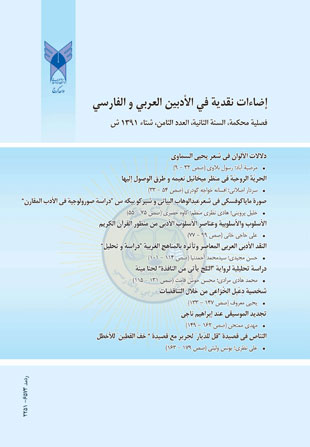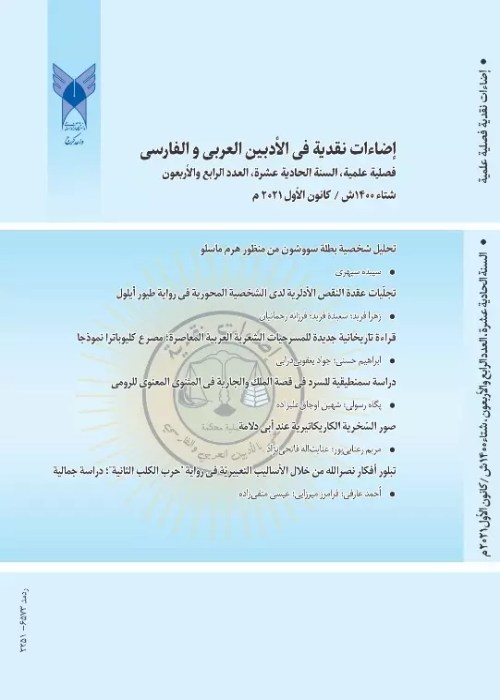فهرست مطالب

فصلنامه إضاءات نقدیه فی الادبین العربی و الفارسی
پیاپی 8 (شتاء 2012)
- تاریخ انتشار: 1391/12/15
- تعداد عناوین: 9
-
-
صفحات 9-32
-
صفحات 115-131
-
صفحات 133-147
-
صفحات 149-162
-
Pages 9-32Color displays the aesthetic aspects of a work of art, considered as one of its vital elements in artistic structure having a direct implications of the poet's artistic vision, and in most cases, refers to the poet's feelings, being a source of vitality and activity, comfort and reliability, symbolic of the different feelings of sadness and joy.Due to its artistic, psychological, social, and symbolic implications, colors are deemed as the most beautiful phenomena of nature, art and poetry as well as a constituent elements of the poetic image. color should be studied in the context of the poem since the poetic texture determines their effectiveness.This paper is based on descriptive, and statistical analysis, the study of color and its implications in the poetry of Iraqi poet Yahia Alsamawy. The purpose of the census is to paint and show off their poetry. Alsamawy is amongst the greatest poets who has abundantly investigated the symbolic function of colors in his writings. The results of this study has shown that most frequently applied colors in his poems are respectively: green, white, black, red, yellow, and blue.Keywords: contemporary Arabic poetry, Yahia Alsamawy, colors, symbols
-
Pages 33-54Freedom is one of the most beautiful words in human glossary and in West it means behavior control with people's complete will and volition, to which in Islamic thought the rights of God being added. Freedom is two type: 1) social freedom which means that human is free in his/her social and individual behaviors, meaning that other people don’t prevent him/her to reach to his/her goals by imprisoning him/her and/or exploiting him/her. 2) spiritual freedom which refers to human spirit so that the spirit be free from negative and deterrent obstacles. There is a strong relationship between spiritual freedom, the one who achieves spiritual freedom also will realized the social one, too. In this article we study the theories of Naeeme about Utopian or ideal freedom and the ways which he guides liberal human to achieve them in his works in an analytical-descriptive way. We try to illustrate the obstacles of reaching freedom. The main purpose of this research is to analyze the quality of Naeeme's suggestion for reaching spiritual freedom. We chose this topic according to the high position of Naeeme and his valuable views concerning human and his freedom and his guidance toward desirable moral traits and his prevention from moral vices and his specific attention to freedom.Keywords: Naeeme, spiritual freedom, recognition, Faith, indecent traits
-
Pages 55-75Imagology is to search for the image of the other in the literary text. Imagology allows the knowledge of man by man which highlights us the essence of humanity. Then we proceed to a world of brotherhood which is in close contact with us. And if we look at this essence, we will find not only interaction with others which highlights the importance of comparative literary studies in our relations with the other.Wahab al-Bayati and Sherko bekas are great poets in Arabic and Kurdish contemporary poetry, and each of them sang a poem to describe Russian Mayakovsky, and may represent the ego Arab and Kurdish in their relations which has grown out of friendship,oneness,and glorificaion of other.This article attempts through the descriptive - analytical and Comparative approach to compare and contrast the concept of" the Russian other" at in Bayati and Bekas poetry. the Results indicate that the poets have an image of the other Russian in the form of tolerance; and this kind of Image of the Other is one of the most beautiful images read, and the only case of the real exchange.Keywords: Imagology, comparative literature, Mayakovsky, Abdul Wahab al Bayati, Sherko bekas
-
Pages 77-99Many of scholars think that the term of style has two types: verbal style and semantic style. Since the meaning of style in Islamic approach is different from that of western approach, so we have too many different definitions of style. Undoubtedly the elements of literary style also are different in Islamic approach from the western approach. Meanwhile the effective elements in Islamic literary style have not been studied or introduced well. This article examines the issue of literary style and its elements and also views of the ancients in this regard on one hand and stylistics and its elements and views of the Westerners on the other hand.Expressing the differences between the Islamic approach and the secular approach, this article is focused on the analysis of elements of literary style from the perspective of the Holy Quran, for example elements such as instinct and intent, faith and monotheism, mind and emotion, feeling, and the talent, as well as the role of responsibility in this literature. This is what this quick check has dealt with and I would hope to be of some desired goal.Keywords: Style, stylistics, Islamic elements, Holy Quran
-
Pages 101-114Translation is of the most striking manifestations of contemporary Arabic literature.This phenomenon in contemporary Western criticism of the discussions that influenced this effect is due to communication and connection with the Arab literature and West. Contemporaneous cash and cash schools, especially schools Divan Court are external factors affecting research. But the important point is that despite all these effects a society is required that is dynamic culture. Americas since time is not on the cash flows, Arab heritage did not forget the new methods of cash from their roots and the old nobility was not isolated.Keywords: modern Arabic literature, modern Arabic literary criticism, its impact on cash flows west
-
Pages 115-131Hanna Mina is considered as one of the realist writers. He achieved fame in Syria By his first novel al-masabih al-zorq (1945) and in his later works introduced himself as a prolific and talented writer.He was different from the others because the subject of his novels was life problems and he believed that realism can embrace other literary schools such as Romanticism and Symbolism. This approach shows how he uses symbols and other modern techniques in his novels.The novel Snow Comes from the Window is the story of a hero who escapes from fight against tyranny at first but learns principles of fight at different stages and passes the steps of knowledge and her character grows from an ordinary to a revolutionary.This research intended to study the realistic approach of Hanna Mina and explores the implications of some inanimate objects in particular, the role of window in the development of the hero.Keywords: Hanna Mina, realism, Inanimate objects
-
Pages 133-147There are few Shiite poets or authors who have defended the holy prophet(PBUH& HP) and his household and have not been under various accusations. This paper examines the contradictory views of historians in introducing Shiite poets, among which Debel Kazaee (martyred 246 lunar) is selected. The paper tries to answer the following questions: Considering all these contradictions can one rely on the historian's views in introducing Debel Khazaee's personality? Are they possibly prejudiced? Are there any statements which reject their views?This paper questions historian's accusations upon Debel which is in turn answered based on the same charges. The aim is to reveal hidden aspects of charges and compare and contrast historian's views to leave the judgment to the just reader him/herself so that s/he can attain a reasonable conclusion.The assumptions are as follows:1.These historian's views are due to their enmity to Shiite.2. To detach people from Shiite religion there were forced to invent accusations.3. These charges are ordered by tyrannical rulers.Keywords: Debel, historians, Shiite poets, prophet's household
-
Pages 149-162Considered Ibrahim Naji from Rowe Ed renewal and Media contemporary Arabic poetry and the mode of the contract between the Poets Egyptian Glory Dean, who Tat By Poets of the modern era. Renewal has going on in different angles, some T. New in the music and poetry in his imagination, but in the And Methods. This research tries in the subject Renewal Music when the poet's glory D On the road to the investigation and characterization and analysis. From the results of this research felt like Naji Balmoshat Andalusian poet and use the weights also is used instead of the house chopped. Depends on the survivor in his hair of characters that help to highlight the word that fits the atmosphere of psychological meaning. That «Nagy» remade in the music of poetry and imagination, but in words and ideas and…Keywords: Group Apollo, Romance, Renewal, Music, Hair, Ibrahim Naji
-
Pages 163-179There are several critical scrutinies in contemporary literature. Intertextuality is one of these. It is a new critical idiom inserted to Arab world from the West which has several kinds that literary intertextuality is one of them which means the interference of past literary texts to the present ones. This kind of intertextuality is visible in Naqaes. This paper tries to discuss literary intertextuality in the Jaria's ode "QOL LELDIARE" from NAQAES, by Akhtal's ode "KHAF ALQATIN" and its goal is to show the level of dialogue and interference in form and content of both odes.Keywords: literary intertextuality, form intertextuality, content intertextuality, Jarir, Akhtal


